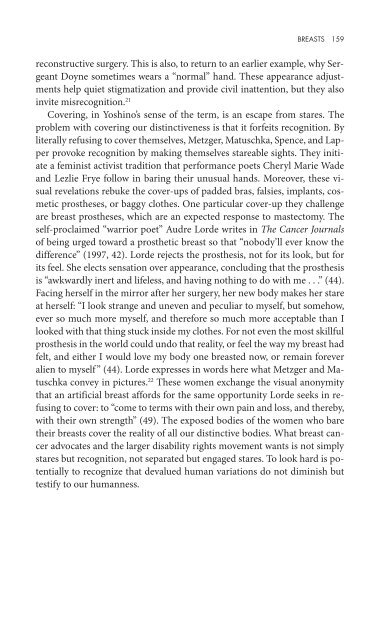Staring how we look sobre la mirada.pdf - artecolonial
Staring how we look sobre la mirada.pdf - artecolonial
Staring how we look sobre la mirada.pdf - artecolonial
Create successful ePaper yourself
Turn your PDF publications into a flip-book with our unique Google optimized e-Paper software.
REGULATING OUR LOOKS 75<br />
need to be simi<strong>la</strong>r to our fellow citizens, as the philosopher Charles Taylor<br />
(1994) points out. To be accorded the equal respect that democracy promises,<br />
<strong>we</strong> need to be wholly ourselves and at the same time just like everyone<br />
else. <strong>Staring</strong> is the social f<strong>la</strong>sh point where these competing demands for<br />
distinction and homogeneity collide. As a recognition of human variation,<br />
staring validates our individuality, calls out our differences from others.<br />
Sameness does not merit stares. But even though stares affirm our distinctiveness,<br />
<strong>we</strong> can never be sure of the meaning attributed to our personal<br />
idiosyncrasies by our visual inquisitors. So our belief in pliable appearances<br />
becomes a dilemma about whether to hide or disp<strong>la</strong>y our differences. This<br />
communal worry about seeing and not seeing, being seen and not being<br />
seen, rises to a new intensity under the scrutiny of stares.<br />
Despite our uneasiness about <strong>look</strong>ing at each other too keenly, <strong>we</strong> gawk<br />
relentlessly at the myriad spectacles American life began abundantly providing<br />
by the <strong>la</strong>te nineteenth century. 14 Today, <strong>we</strong> navigate a daily ava<strong>la</strong>nche of<br />
reiterated images that at once stimu<strong>la</strong>te and enervate us. The surging demands<br />
that <strong>we</strong> produce and consume bid us insistently to <strong>look</strong> at products<br />
and expect the life they promised. Indeed, Walt Whitman, the poetic voice<br />
of nineteenth-century America, exalted public viewing as our national virtue<br />
and right: “ . . . what I am,” writes Whitman in Song of Myself (1900),<br />
“Stands, amused, comp<strong>la</strong>cent, compassionating, idle, unitary, / . . . Looks<br />
with its side curved head curious what will come next, / Both in and out<br />
of the game, and watching and wondering at it” (lines 74–78). The rapidly<br />
changing world Americans <strong>we</strong>re gaping at was filled with new things to see<br />
and new ways to see them. Nights <strong>we</strong>re aglow with new artificial light. Gas<br />
street <strong>la</strong>mps and electric home lighting dazzled the eye. Civic celebrations of<br />
progress and nationalism flourished. The World’s Columbian Exhibition of<br />
1893, for instance, drew 716,881 people on a single day and the 1927 ticker<br />
tape parade for Charles Lindbergh in New York City attracted four million<br />
spectators. Even <strong>la</strong>dies, if properly accompanied, might risk this kind<br />
of staring. Most novel to Americans out on the street and <strong>look</strong>ing around<br />
was merchandise. The burgeoning commercial culture and the beginnings<br />
of consumerism demanded disp<strong>la</strong>y and desirous <strong>look</strong>ing. Ladies, especially,<br />
could shop in order to fill their role as ornaments that disp<strong>la</strong>yed the status<br />
of the men on whose arms they gracefully leaned. Spectacles such as the<br />
Macy’s Thanksgiving Day Parade, begun in the 1920s, fused commercialism<br />
with traditional forms of spectacle such as religious carnivals and processions.<br />
Ersatz tableau vivants behind department store windows allo<strong>we</strong>d<br />
Americans to <strong>look</strong> at new goods and imagine them as indispensable. 15 This<br />
appetite for the new animated American eyes.<br />
All of this excited <strong>look</strong>ing occurred at the same time that the prohibition<br />
against staring at one another was being codified in conduct manuals and


